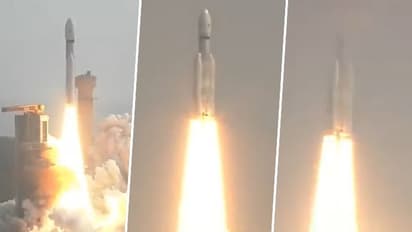ISRO's heaviest rocket LVM-M3 lifts off smoothly in its sixth mission with 36 OneWeb satellites

Synopsis
The company which has Bharti Enterprises as a major investor, is implementing the constellation of low earth orbit satellites In a notification on Saturday, ISRO said, "LVM3-M3/OneWeb India-2 mission. The countdown has commenced."
Indian Space Research Organisation (ISRO) on Sunday (March 26) successfully launched its heviest rocket Launch Vehicle Mark-III (LVM3-M3)/OneWeb India-2 Mission from Satish Dhawan Space Centre in Sriharikota, Andhra Pradesh. This would be the second launch of ISRO in 2023 after the successful launch of SSLV-D2/EOS07 mission in February.
Network Access Associates Ltd, United Kingdom (OneWeb Group Company) had signed an agreement with ISRO's commercial arm NewSpace India Ltd to launch 72 satellites into Low-Earth orbits (LEO). On October 23, 2022, ISRO had launched as many as 36 satellites of OneWeb. It was the first satellite deployment collaboration between the two organizations.
The company which has Bharti Enterprises as a major investor, is implementing the constellation of low earth orbit satellites In a notification on Saturday, ISRO said, "LVM3-M3/OneWeb India-2 mission. The countdown has commenced."
OneWeb said, "17 launches completed. One pivotal launch remains - OneWeb Launch 18. As we launch another 36 satellites with our colleagues at ISRO and NewSpace India Ltd this weekend (March 26), we will reach 616 satellites in-orbit, more than enough satellites to launch global services later this year."
Also read: Amritpal Singh dons jacket, sunglasses in latest videos; ditches traditional clothes
ISRO had said that the launch vehicle mission would place the 36 first generation satellites weighing 5,805 kgs into a 450 kms circular orbit with an inclination of about 87.4 degree.
This is the sixth flight of LVM3 which was earlier known as Geosynchronous Satellite Launch Vehicle MkIII (GSLVMkIII). It had five consecutive missions including the Chandrayaan-2.
Stay updated with the Breaking News Today and Latest News from across India and around the world. Get real-time updates, in-depth analysis, and comprehensive coverage of India News, World News, Indian Defence News, Kerala News, and Karnataka News. From politics to current affairs, follow every major story as it unfolds. Get real-time updates from IMD on major cities weather forecasts, including Rain alerts, Cyclone warnings, and temperature trends. Download the Asianet News Official App from the Android Play Store and iPhone App Store for accurate and timely news updates anytime, anywhere.